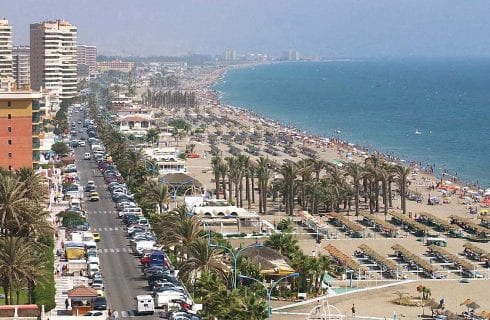by Mark Roulston
ÚBEDA lies 50 kilometres or so to the east
of the capital of its province Jaén. Standing on an
escarpment, it is surrounded by gently rolling hills dotted by neat rows of
olive trees. This is no exaggeration but there are millions of them. For the
town is oil rich – but not from the black stuff, mind: we are talking olive oil
here. Wherever you go in the town you are reminded of this – shops specialising
in the stuff, bonsai-sized olive trees for sale and your tapas
in the bars come swimming in it.
On the down side, however, if you suffer
any allergic reaction to olive pollen it is worth bearing in mind that you
should stay away when levels are at their peaks, roughly from early April to
June. On our first visit in the middle of May, most of the population was
wearing face masks to stop those unrelenting sneezing attacks and itchy as hell
eyes.
{mosimage}
If you stand at one of the many viewpoints
on the eastern edge of the town, you can see the mountains of the Cazorla,
linguists claim the word úbeda is of Basque origin. It
is a suffix meaning mountain spring. Crane your head to the west and you may
see the smaller and more famous – and perhaps prettier – town of
World Heritage Site since 2003.
We visited Úbeda
on a late September day. It was our second trip to the town, tucked away in a
northern corner of Andalucía. We had been promising my parents we would take
them for several months since our initial visit. So they came with us to visit
one of our favourite Andaluz towns.
The main tourist draw in the town is the
Plaza de Vázquez de Molina. Named after one of the
noble families, those self-styled Lions of Úbeda that
governed the town after it was reconquered from the
Moors in the 13th century, it contains more Renaissance mansions and churches
than you could ever expect to see in one single visit. If time is of the
essence make the Palacio de las
Cadenas and the Chapel of El Salvador the buildings
you see.
Today, the Palacio
de las Cadenas – or the Palacio de Vázquez de Molina as
it is called in some guidebooks – is home to the town’s council. It was built
in 1568 as a home for Juan Vázquez de Molina, the
private secretary of King Felipe II. Like most of the Renaissance buildings in Úbeda, the palace was constructed with weather resistant
sandstone blocks.
The building, as does the Nuestra Señora de la Victoria
church in Málaga, hides an attractive arcaded
courtyard inside. To access it, you need to go to its entrance at the rear of
the building on Plaza del Ayuntamiento.
The Chapel of El Salvador is considered to
be one of, if not the, finest example of Spanish Renaissance architecture. It
was built in 1536 by Diego de Siloé, he responsible
for the cathedrals of
a stone carving of the Transfiguration of Jesus on its façade – a poorer cousin
of the interior carving of the same scene.
{mosimage1}
The Plaza de May 1 is a quaint little
square. It is surrounded on all sides by buildings with lavish facades and
luxury interiors. The square once held burnings during the Spanish Inquisition.
But during our visit it was transformed into a sea of empty plastic beer
glasses and discarded paper plates: it was the local feria
de tapas.
We walked over to a stall in the northern
corner and had a glass of beer. Nine spotty Guardia Civil trainees – on leave
from the town’s civil guard training barracks – were also there, getting
gradually more and more drunken.
I noticed they were all unarmed but had
something more dangerous than a weapon – a false bravado given to them by that
olive green uniform and inebriety makes for a dangerous cocktail. So, we
drained our glasses and left.
We decided to visit the
the northern end of the plaza. To enter, we had to fight our way through a
crowd of elegantly dressed smokers in the door way. A late summer’s wedding was
underway so our visit was only brief.
The church is a hotchpotch of a place
incorporating architecture from the Renaissance, the Gothic and Romanesque
periods. I am of the opinion once you have seen, say, five churches you have
probably seen them all (with a few notable exceptions) and this place did
nothing to change that.
We left the church and walked along Calle Losal to the town’s old
walls and the potter’s quarter beyond. Here, traditional terraced houses double
as the workshops and homes to the town’s existing master craftsmen. Ubeda’s pottery is quite different from that of
blue and white are the colours of that province, a brilliant deep green is the
colour here. We were told by the assistant in one shop in the quarter this is
due to the system of firing the pottery – a method used since the town was
known as Obedah under Moorish rule six centuries ago.
Olive stones are added to the fire to create a thick smoke, giving the pottery
its colour and sheen.
We walked back along Calle
Losal and through the
to visit the Oratory of Saint John of the Cross. Here, the Saint died of
gangrene in 1591 after his escape from imprisonment in
Juan de Yepes y Alvarez 49 years before his death in
the
served the “poorest of the poor” (New Advent Catholic Encyclopedia, online edition, 2003) barefooted. Here in Ubeda, he produced two poems considered to be among the
very best in the Spanish language: Spiritual Canticle and the Ascent of Mount
Carmel.
We found the building was closed to
visitors. My former altar boy of a father told us that
Cross is one of the 33 Doctors of the Church, those from whom the Christian
Church obtains its teachings. On hearing this, I suggested a trip to the
Hospital de Santiago before being told “doctor” was from the
classical Latin docere or, to teach.
The hospital lies
a short walk along Calle Obispo Cobos
off the central modern Plaza de Andalucía. To reach it, you must first re-enter
the 21st century and pass the Mangos, the Zaras and
the many other High Street shops. The hospital was first commissioned by Diego
de los Cobos – born in the
town and bishop of Jaén – in 1562. Like many of the
buildings in the old part of Úbeda, the hospital was
built by Renaissance architect Andrés de Vandelvira. It was finished in 1575 for the town’s poorly poor: never have the sick been treated in such
opulent surroundings. The building has been described as “Andalucía’s
there is a certain similarity between that monastery to the north of
hospital. Both have domed towers, palatial staircases, central courtyards
leading on to minor courtyards. And both were influenced, in part, by the
Today, it is a hospital in name only. Since
1975, the building has played host to countless theatre plays and concerts. It
is now a cultural centre with the sick being treated at a modern hospital at
the edge of town.
I do, however, judge a place I am visiting
not on its churches, buildings and history but on its restaurants, bars and
people and Ubeda has something that probably knocks
most Renaissance towns around
the place I non sycophantically call The Best Place to
Eat in
quality regional food for next to nothing then I am sure you will agree with me.
Owners Antonio and Mary have had the
restaurant for more than 35 years. Since 1969 the husband and wife team have
been feeding those hungry ubetenses, as the locals
are known. The décor of the restaurant, which stands at the edge of the old
town at the top of Calle Trinidad, is eclectic to say
the least. On the walls hang examples of the local pottery, charity shop
quality portraits of unknown people, the coats of arms of all the major andaluz cities, yellowed photographs with curled corners
and posters advertising bullfights long gone. The tables are all of different
shapes and sizes and the crockery from upon which you eat your food does not
match. One plate may be gilt-edged, another with a flowery blue pattern, the
next with red birds flying around the rim. At first glance many a person must
have thought the place was nothing but shabby. But get past this and you
immediately feel at home with the welcome and service you are given.
On a previous visit, we were smack bang in
the middle of boar hunting season: and that is what we had for the main course
in a very generous menu
portions – I had ordered a plate of scrambled eggs with black pudding and
chorizo for my starters; Mary had a bowl of andrajos,
a regional soup of whatever they can lay their hands on. That time it was cod,
vegetables, pasta and prawns.
Antonio then brought us out our boar. It
had been casseroled with mushrooms in a red wine sauce and was delicious.
I then remember Antonio gently chiding us
for not being able to leave a clean plate.
So, this time I promised to order more
sensibly and show less gluttony. We walked in and Antonio immediately
recognised us from that initial visit four months before. “Will you finish
your main course this time,” he joked.
We were shown to our table and my wife and
I only picked at the complimentary salmorejo, patatas ali
oli, tomato salad and local spicy bread sticks on
offer. My parents set about the free food as if they had not eaten in days. We
warned them what was to come but they did not listen. It was a mistake we had
made on our last visit.
Our orders were then taken. Being in the
middle of bullfighting season my father and I asked for bull’s tail, Mary
chicken and my mother the boar. But first the starters.
My father had always wanted to try migas. He asked for this and the bread
crumbs fried in lard came with two links of chorizo sausage, black pudding, a
fried egg and two or three roast green peppers. The rest of us had the andrajos – this time with rabbit, its liver and kidneys,
prawns and clams. Mary and I shared half a litre of red; my mother and father
half a litre of white. The price with dessert was 60 euros.








